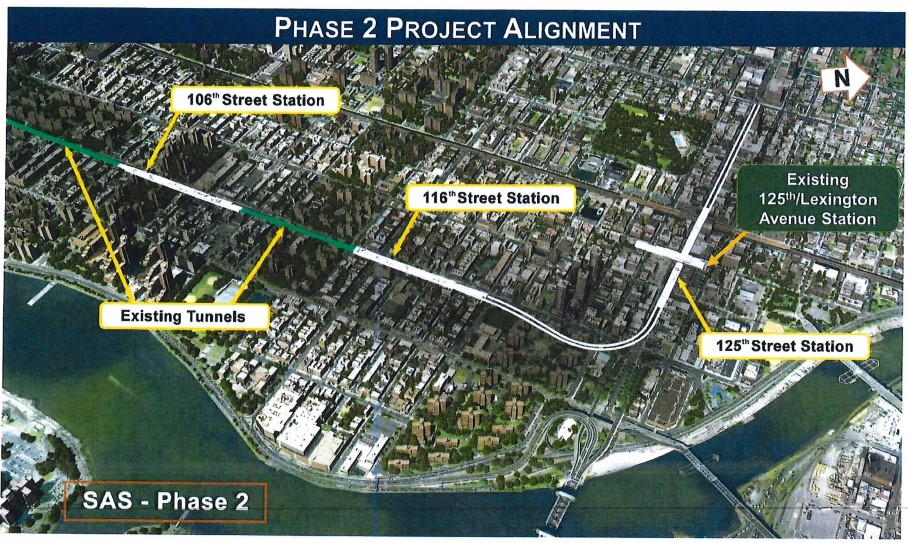
Phase 2 of the 2nd Ave Subway has been in the news recently as President Biden proposed a $2 trillion infrastructure bill. Senate Majority Leader Schumer has pushed for funding Phase 2 of 2nd Ave so it’s very possible that, if funding arrives by the end of the year, construction can start soon (at least preliminary work since Covid is still slowing down the MTA.)
The original phasing concept for the 2nd Ave Subway was that as one phase wound down resources would be moved to working on the next phase and construction would start seamlessly as the previous phase opened. Governor Cuomo threw a wrench into those plans when he raided MTA funds, resulting in the MTA to push off major work on Phase 2 into the next Capital Plan.
Phase 2 will extend the existing subway from 96th St and 2nd Ave to 125th St and Lexington Ave. The subway will start to curve west at 120th St and will feature provisions for a future branch to the Bronx. The 125th St terminal may end up being the most expensive subway station ever built. The Lexington Ave Line is double stacked at this point meaning that the new station needs to be extra deep. In order to make construction “easier” the MTA plans on carving the station out of bedrock rather than digging up the street cut-and-cover style. Like with the cavern stations on Phase 1 and East Side Access, these deeper stations require more emergency support services to be built which drives the costs sky high.
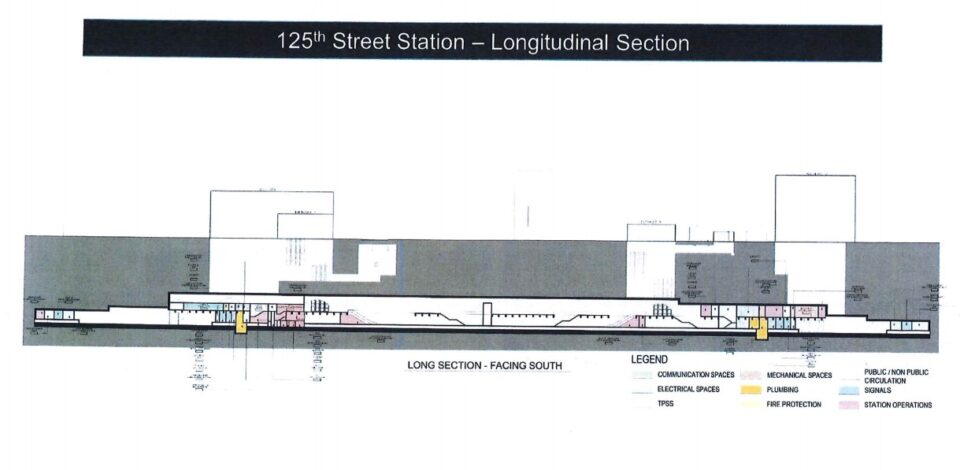
While no official price tag has been released, a ball park figure which has been bouncing around is $6 billion. The first phase of 2nd Ave is already the most expensive mile of subway ever built and it looks like the MTA is trying to outdo themselves. To give them some credit, the high price tag has forced engineers to look at cost cutting solutions such as smaller ancillary structures, an alignment requiring fewer surface level buildings to be seized, and reusing the existing tunnels under 2nd Ave which were built in the 1970s.
As of this writing no up-to-date engineering documents have been released to suggest further cost reductions so critiquing the design will have to wait for another day. But something that always comes up on subway/rail fan message boards and social media is the idea that Phase 2 should not run down 125th St but instead run up to the Bronx like all previous plans have suggested. Some have even claimed that it would be cheaper to do this. So, I’d like to take a close look at these ideas.
Bronx Lines
The Lexington Ave trunk line has three branches in the Bronx: the 4 along Jerome Ave, the 5 along White Plains Rd and Dyre Ave, and the 6 to Pelham Bay. These branches cover a very large swath of the entire borough and as such pick up a substantial number of riders, funneling them all down Lexington Ave. While these branches cover a good portion of the borough they feature a number of problems which limits their effectiveness. The 2nd Ave Subway, from its introduction in 1929, was intended to pick up enough of this ridership as to relieve the crowding on the Lexington Ave Line.
The Lexington Ave express trains split at 149th St with 4 trains continuing north to Woodlawn and 5 trains switching over to the White Plains Rd Line, reverse branching with the 2. This merge was built in a very strange fashion and requires 5 trains to make a very sharp, long curve at slow speeds. This merge causes all trains to back up, resulting in delays. Further up the line at 180th St, 5 trains branch off to Dyre Ave. The merge at 180th St also causes problems, poorly designed as the Dyre Ave Line was originally a commuter rail line which was grafted on to the subway in the 1950s. Additionally, some 5 trains originate at Nereid Ave at the end of the White Plains Rd Line. This splits service even more so that Dyre Ave trains have much longer wait times between trains.
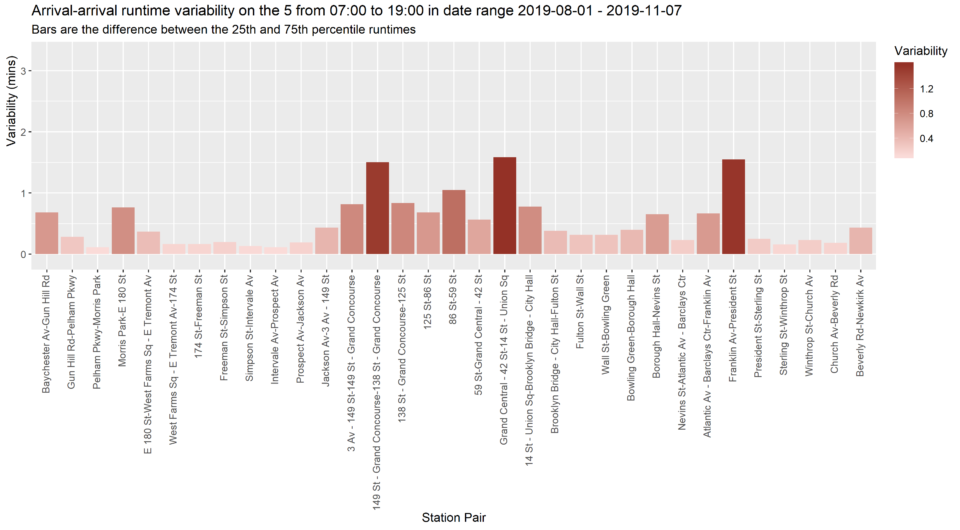
The Lexington Ave local, the 6 train, runs exclusively on the Pelham Line, branching off the Lex at 125th St and running down 138th St to Southern Blvd, then north to Westchester Ave where it runs east to Pelham Bay Park. The 6 features peak direction express service from Parkchester to 3rd Ave. This dramatically cuts running time along route but poor switch layouts delay trains switching between the express and local tracks.
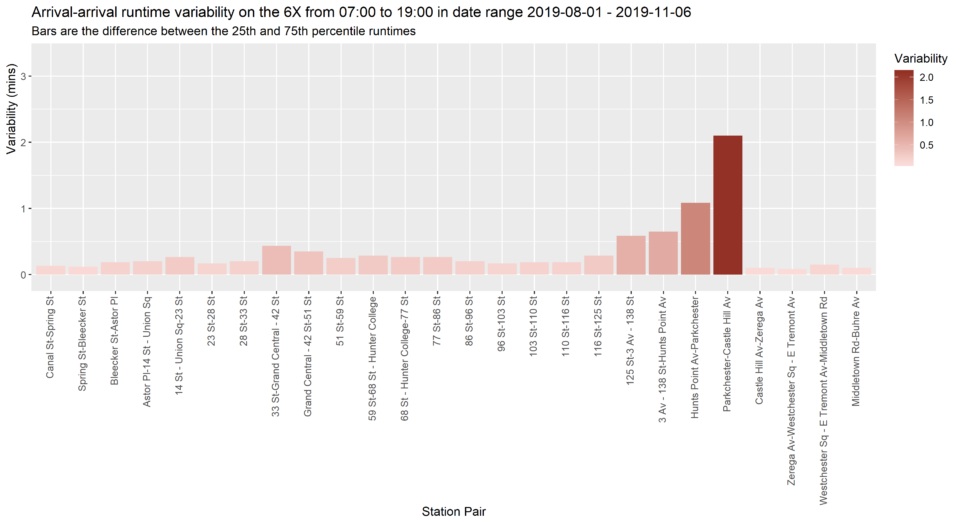
Thus, each branch of the Lexington Ave Line has physical constraints which limit overall capacity. This might not be the end of the world for most subway lines but being the only subway trunk line along the east side of Manhattan means that every extra train counts. So then, it seems like extending the 2nd Ave Subway into the Bronx is a no brainer. Except the Bronx doesn’t need it.
Does the Bronx need a new subway?
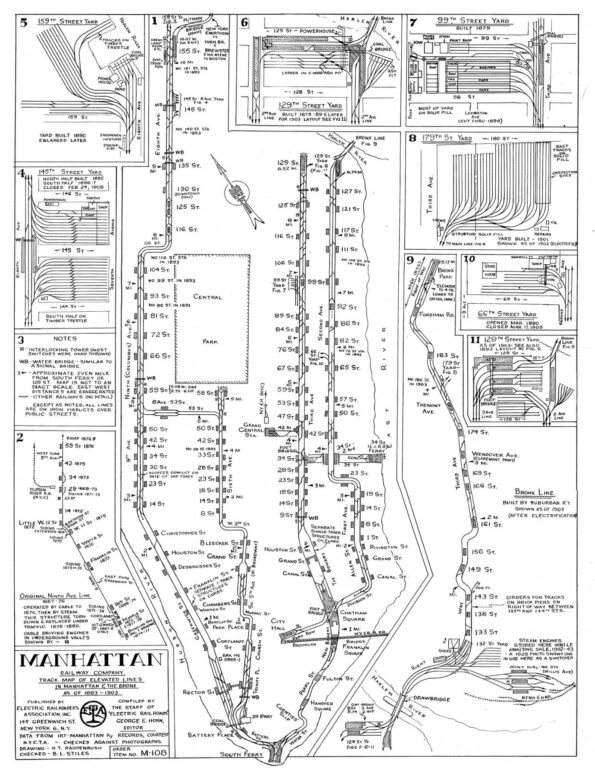
I think the biggest reason so many railfans want to see the 2nd Ave Subway running up to the Bronx is to right an old wrong. The 3rd Ave El, which at its height run from Wakefield to South Ferry, helped fill in the transit gaps through central Bronx. It ran almost equidistant from the IND Concourse Line and the IRT White Plains Rd Line. The section from South Ferry to 149th St was torn down in 1955 as an overly eager city prepared for building the 2nd Ave Subway. The development came but the subway didn’t. The northern section limped along until it was town down in 1973.
The 1968 Program for Action proposed replacing the 3rd Ave El not with the 2nd Ave Subway but with a branch off of the Lexington Ave Line starting at 138th St. The 5 train would be rerouted along the Metro North Harlem Line tracks and run up to Wakefield. Like with most of the rest of the Program for Action, nothing ever got off the drawing boards.
Is it worth bringing the 3rd Ave El back?
Let’s look at the numbers.
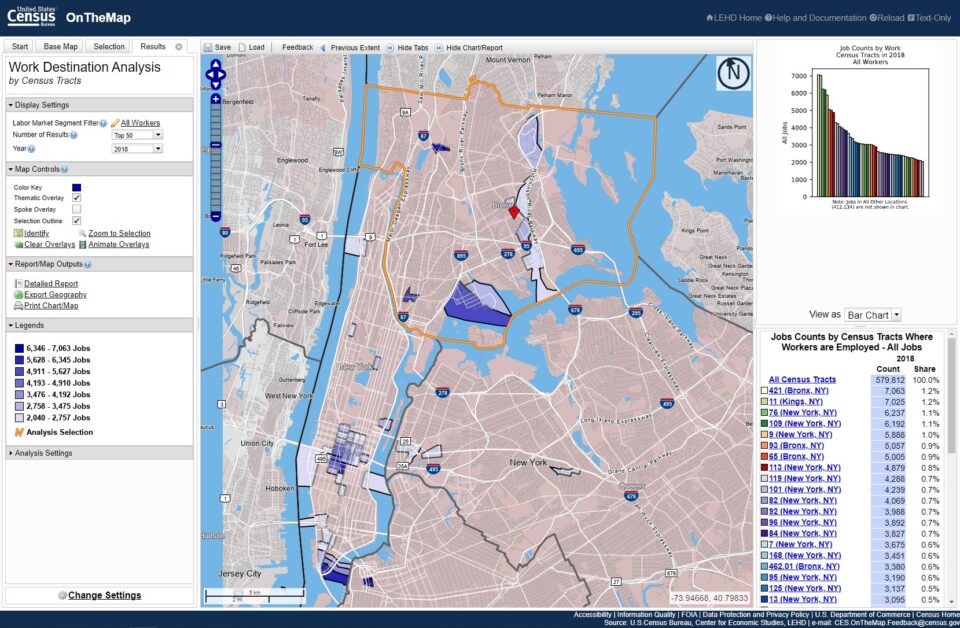
Of the almost 580,000 workers in the Bronx:
- 38.5% work in Manhattan
- 23.4% work within the Bronx
- 9.5% work in Queens
- 9.4% work in Brooklyn
- 7% work in Westchester
- 4.4% work on Long Island (Nassau + Suffolk)
The rest work scattered around the tri-state region.
That means there are about 333,000 commuters from the Bronx to the other boroughs. Not all are using the subways but assuming they could, would our current network be able to handle them?
At pre-Covid frequencies there are a maximum 93tph entering Manhattan from the Bronx at the AM rush hour. Calculating the capacity based on A Division trains (R188: 1,832 rider capacity) and B Division trains (R179: 2,400 rider capacity), these 93 trains can handle 181,168 riders per hour. Not every worker who is commuting to Manhattan is coming in at rush hour but even if they wanted to, every commuter could fit on each subway car between the hours of 8-10am.
Therefor the current subways between the Bronx and Manhattan are not overcrowded and don’t justify a new line.
What does the Bronx need?
Just because the Bronx doesn’t need more subway lines doesn’t mean that the trains we run today are serving the borough in the best way possible. We have a legacy system which has not seen a new mile of track since before World War II. The Bronx was laid out as an urban suburb of Manhattan and while this is still the case, it isn’t the entire picture. Almost a quarter of workers commute within the Bronx itself.
Looking at Census data we see the core areas of employment are:
- Hunts Point: Hunts Point is one of the last thriving industrial centers in New York City and accounts for 8,000 jobs from Bronx commuters. The area is served by the 6 train but this is up a mile away from many of the major job centers.
- Norwood: The Montefiore medical center on West Gun Hill Rd and surrounding businesses accounts for 7,000 jobs. This center is served well by the 4 train at Mosholu Pkwy and the D at Norwood-205 St but commuters from the eastern Bronx either drive or rely on buses.
- The Hub: Considered the downtown of the Bronx, the Hub exists at the crossroads of 3rd Ave and 149th St and accounts for 5,000 jobs. The Lincoln Medical Center is the largest employer in the area. The area is served by the 2 and 5 train and the 149th St station is the station with the second highest ridership in all of the Bronx (after Yankee Stadium) [2019 numbers]
- Co-Op City: While Co-Op City is thought of more for its iconic Tower-In-A-Park, the entire complex was designed as a mini-city and account for almost 3,400 jobs. Many are in the southern section where there are a number or retail stores and malls. There are a number of medical centers throughout and in the northern section there are light manufacturing and an MTA bus facility. While there were plans from the start to extend the 6 to Co-Op City, this was never done. Today there are plans to build a Metro North stop along the Northeast Corridor as part of the Penn Station Access project, but this station would be on the extreme southern tip of Co-Op City and be located on the other side of the Hutchinson River Pkwy, beyond easy walking distance.
- Directly south of Co-Op City, the Hutchinson River Parkway runs along the Westchester Creek. This corridor accounts for over 10,000 Bronx jobs. The corridor is mostly manufacturing but also home to the Albert Einstein College of Medicine, Mercy College, Yeshiva University, countless big box retail stores, and home to many of the city’s school buses. The closest subway station is the 6 at Westchester Sq but as part of the Penn Station Access project a station is bring proposed at Williamsbridge or Eastchester Roads.
It’s hard to judge this data based on just the subway. While areas like the Hub and Norwood are served relatively well, it’s hard to argue that Hunts Point is exactly well served by the subway, and much of the Coop City-Westchester Creek corridor has no subway access whatsoever.
The missing piece of transit here are the bus lines. The Bronx has relatively good bus coverage around the borough. Looking at the top 9 bus routes we begin to see a trend:
- Bx12 SBS: 13m annual riders
- Bx1/Bx2 8.6m
- Bx9: 7m
- Bx19: 6.9m
- Bx36: 6.9m
- Bx6: 6.7m
- Bx15: 6.6m
- Bx40/42: 5.8m
- Bx41 SBS: 5.7m
- Bx35: 4m
- (Note, Bx7 only took over 10th place from Bx35 last year)
All but two of these routes run crosstown, either entirely or along much of their route. The Bx1/Bx2 is a hybrid as it technically runs crosstown at its northern and southern ends but acts as a radial line along the Grand Concourse. The only true radial lines are the Bx15 and Bx41 SBS. These are the two bus lines which took over from the demolished 3rd Ave El. The two lines combined have a ridership of 12.3m ridership which, if it was one route, would have the second highest ridership in the borough behind the Bx12 SBS.
Taking into account subway ridership, bus ridership and job centers a clearer picture emerges. The most obvious first step is that the crosstown bus lines with highest ridership need to be strengthened with dedicated bus lanes and faster service. Thankfully the MTA has been working with riders to redesign the network with this goal in mind. More bus lanes are being proposed along East 149th St, East 167th/East 168th Streets, East Gun Hill Rd, and the length of Tremont Ave (among others).
Some of the crosstown lines will also have their routes simplified to speed up travel. While I like what I see from most of the proposals, I feel like there are some connections being missed. The Bx35 today ends at Gladstone Sq and is being proposed to instead turn around north of there at Freeman Triangle. This line still ends just a few blocks from the Whitlock Ave station on the 6 train. Why not have the Bx35 continue to Whitlock Ave instead and give Pelham Line riders a simple transfer to crosstown service?
A big change which seems strange to me is that the Bx6 SBS is going to be rerouted from Hunts Point to Castle Hill. I think bringing SBS service into the Soundview area of the Bronx would be a boon, but given the number of jobs in Hunts Point and the ridership on the line already I don’t see why cutting the SBS portion there makes any sense. Keep the Bx6 where it is and convert the Bx5 to SBS through Soundview.
Looking at the jobs along the Westchester Creek it seems strange that there are no direct bus lines serving this corridor today nor are any proposed. The closest bus line to the area today runs along Castle Hill Ave but this is a third of a mile away. Castle Hill Ave is certainly more centrally located running through dense residential areas, but it veers away from the Westchester Creek area through Parkchester. I’d like to see the Bx31, which today ends at Westchester Sq, extended south along Zerega Ave to Lafayette Ave. Here it can either continue south along Zerega Ave or move over to Castle Hill Ave.
Potential Rail Corridors
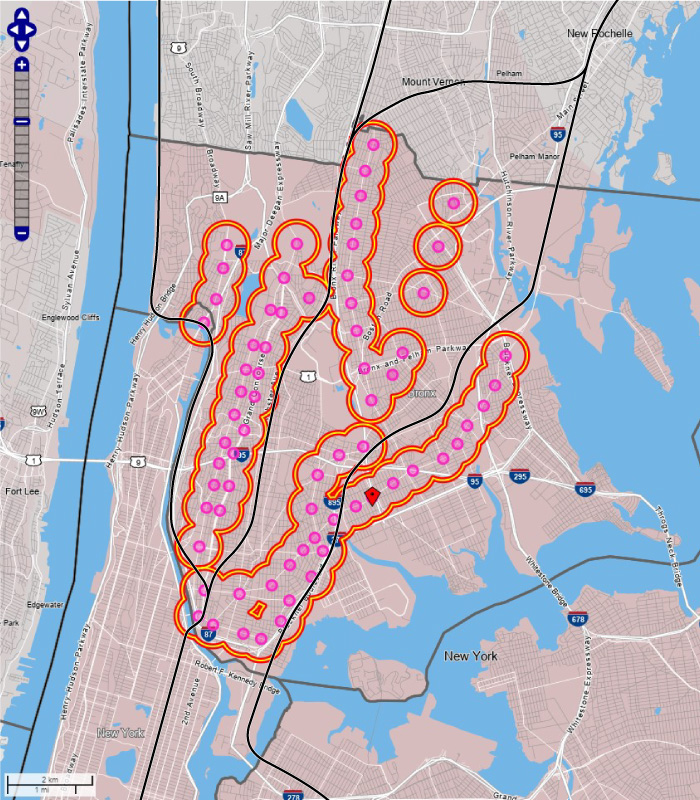
Looking at the subway map of the Bronx one can spot two obvious unserved corridors, one between the Grand Concourse and the White Plains Rd Lines (where the former 3rd Ave El once ran) and a large swath through the eastern Bronx between the Dyre Ave Line and the Pelham Line. Running down the center of these two corridors are two major commuter rail lines.
As mentioned, post-World War II all passenger rail carriers saw massive drops in ridership. Cities with established rapid transit systems quickly saw the potential for converting these lines into subways. NYC Picked up the bankrupt New York, Westchester and Boston Railway in 1940 and the LIRR Rockaway Beach Branch in 1955. The LIRR Port Washington Branch was also seen as a candidate for conversion.
Today commuter rail ridership has rebounded to the point where the existing concept of higher service at rush hours and high, distance-based fares are becoming a limitation for expanding ridership. In Europe most systems have converted to a Regional Rail approach which sees higher frequency throughout the day with simplified fare structure, often integrated with subway and bus networks. Therefore subway-level service can be achieved with an existing system for far less investment.
While the concept of Regional Rail is just catching on in the US (most notably the MBTA in Boston), the MTA is beginning to dip their toes into the water. The Atlantic Ticket is a pilot program that introduced lower fares on the LIRR Atlantic Branch, although it still does not offer free transfers to busses and the subway. Penn Station Access has been in the works for many years and proposes adding four “new” stations along the NEC through the eastern Bronx (Hunts Point, Parkchester, Morris Park, and Co-Op City.) This service would bring Metro North service into Penn Station and would open after the East Side Access project which will bring the LIRR into Grand Central.
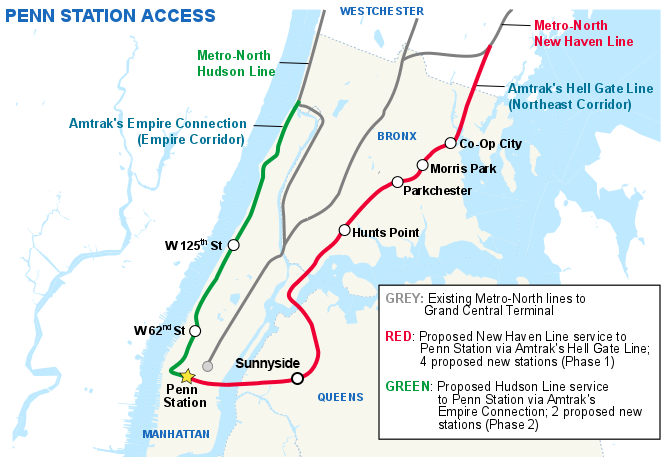
Both the NEC, which is the former New York, New Haven and Hartford Railroad, and the Metro North, formerly New York Central Railroad, Harlem Line had a number of stations within the Bronx which were closed over the years. Penn Station Access plans to reopen a few, but not all of these stations. The Morris Park station in particular will offer better access to the jobs along the Westchester Creek corridor. The station at Co-Op City is in a much less convenient location and will require a transfer to a bus to access jobs and the majority of residences in Co-Op City.
The Harlem Line presently has stations at Melrose (161st St), Tremont, Fordham, Botanical Gardens, Williams Bridge, and Wakefield. The Harlem Line runs parallel to 3rd Ave, as close as two blocks away. There were once stations at 138th St, 169th St, Claremont Parkway, and 183rd St. Additionally, there was also a proposal to build a station at 149th St which was never acted upon. If the stations are rebuilt then the 138th St station should be moved to 149th St instead.
Currently the Harlem Line runs at 15tph in peak directions, although reverse peak is often a third of this. By reopening these stations, running more reverse peak trains, and reforming the fare for inner city trips that of the subway or express bus, the MTA can effectively recreate the 3rd Ave El service levels. This service would run express from 125th St to Grand Central and be effective at taking pressure off of the Lexington Ave express where it’s most congested.
These rail and bus improvements could be done very quickly and affordably. The new OMNY Card system can better track where riders enter and exit the system so that lower fares and free transfers are possible along the line. If a rider needs to go to Westchester, then the fare will be adjusted automatically.
Fixing the IRT
The number one way to improve subway service in the Bronx isn’t to extend the 2nd Ave Subway but to fix the many bottlenecks which limit the system. The IRT has the most egregious ones with grade crossing trains at 143rd St in Harlem and Rogers Junction in Brooklyn. The curve between the 2 and 5 trains at 149th St slows down service throughout the entire network and poor operations between merging express trains at 180th St and Westchester Sq round out the list.
The IRT was designed with an east (Lexington) and west (Broadway-7th Ave) side trunk line which reverse branch in the Bronx and Brooklyn. The Brooklyn trunk was designed relatively well with express and local tracks, although this is all thrown out of whack by the poorly designed Rogers Junction. In the Bronx the Lexington branches and the Broadway-7th Ave branch can operate independently of one another. But because of high east side demand the 5 reverse branches with the 2 along the White Plains Rd Line.
All this branching reduces capacity on each branch and delays caused by reserve branching ripple throughout the entire system. The solution is to deinterline these lines and end reverse branching. The “simplest” way to do this is by eliminating the 5 train entirely and running all Lexington Ave express service along the Jerome Line. The third track along this line, which is not used for regular service, can be used for drop outs. A new flyover track may be needed at Bedford Park Blvd so that this increase in terminating trains doesn’t foul trains to and from Woodlawn.
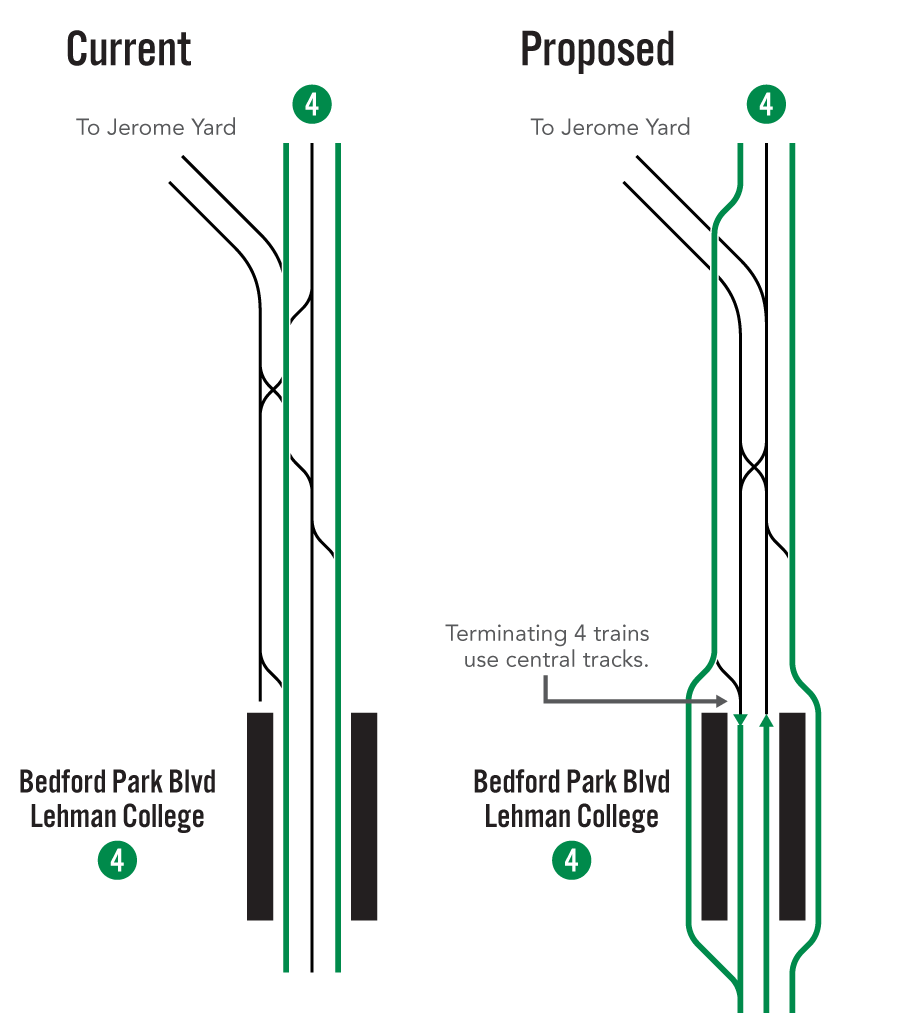
All service on the White Plains Rd and Dyre Ave Lines would be covered by the 2 and 3 trains. Because of the ridership imbalance between the two branches, I propose a ratio of 2:1 for 2 and 3 trains. To make this work the current 3 train terminal at Harlem-148th St would need to be converted into a shuttle to 135th St which would be expanded with a third track to separate shuttle and through trains.

The loss of direct east side service on the White Plains Rd and Dyre Ave Lines is bound to be a major point of contention. This is where Regional Rail can pick up the slack. The new Metro North 149th St station can replace the 5 train for express service to midtown. The existing 149th St-Grand Concourse station would need to be expanded for the larger number of transferring passengers. Current riders may grumble but the higher levels of service on all lines means that this new forced transfer can be made in half the time as a transfer today would take.
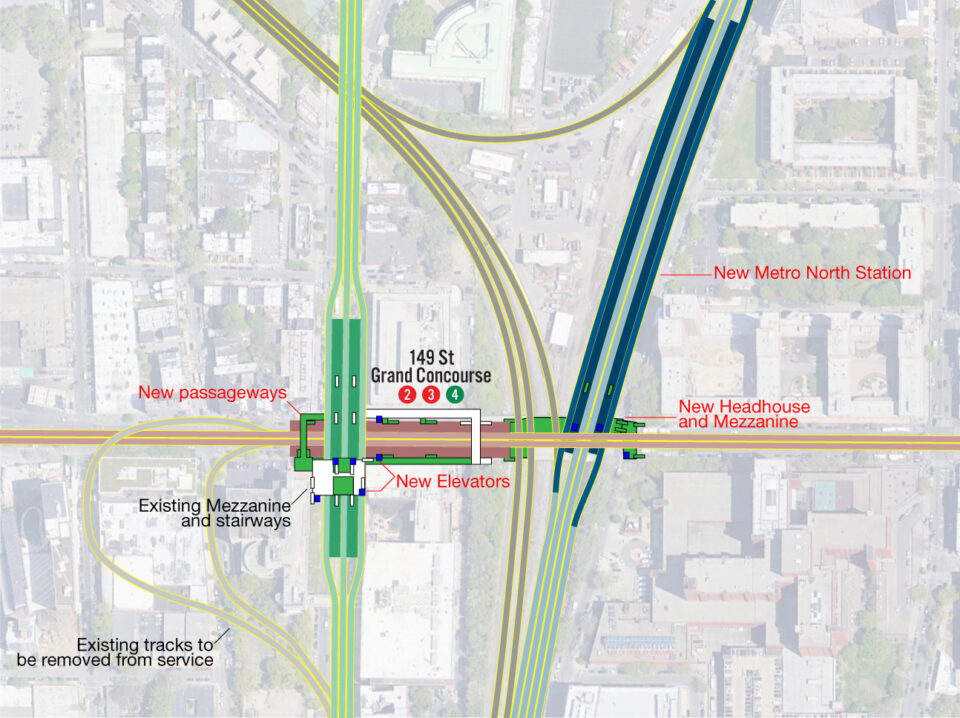
In order for these changes to be effective we must also fix the bottleneck is Brooklyn. The Rogers Junction, between the Eastern Parkway Line and the Nostrand Ave Branch, requires both local and express trains to merge onto the same track in order to procced. This not only causes delays but sets the capacity for the entire A Division. This could all be fixed with the addition of two simple switches which would allow the express trains to bypass the locals.
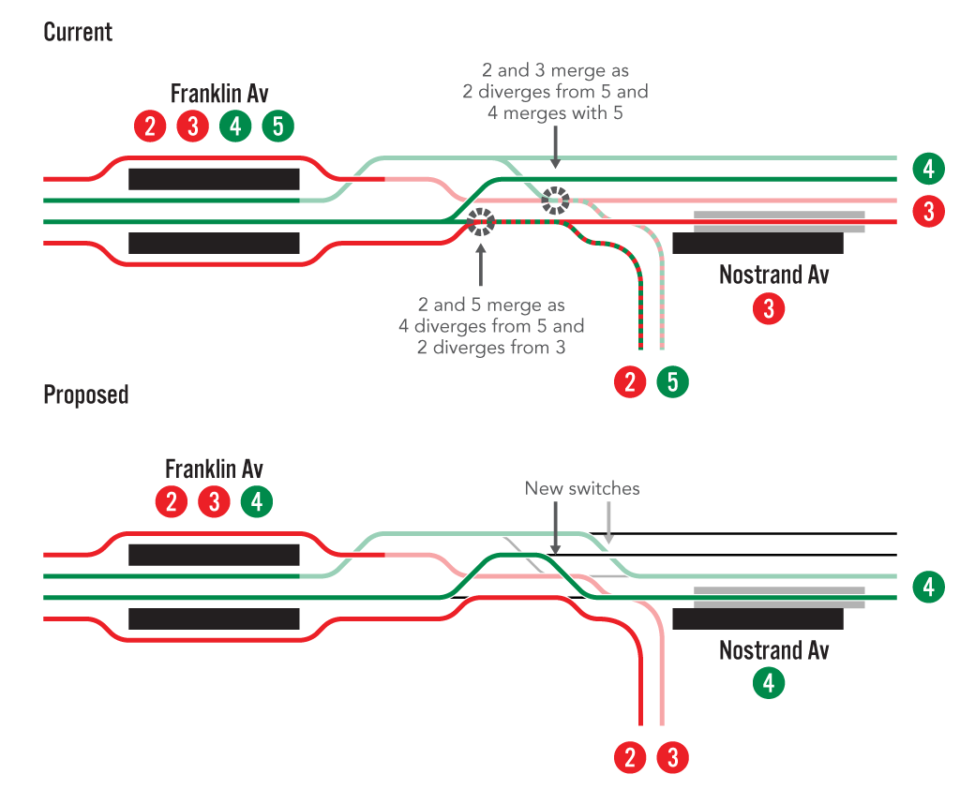
The Nostrand Ave Branch features a reverse branched 2 and 5 train. With the new switches this would have to be simplified to the 2 and 3, the Eastern Parkway locals, while the express 4 continues to New Lots. The 5 train would be eliminated and its service would be picked up by the 4 train, now running at peak capacity. The terminal at Flatbush Ave-Brooklyn College will need to be expanded to allow for trains to enter at higher speeds and for new storage tracks added south of the station to increase capacity.

The 6 train has overall high on time performance because it doesn’t interline with another service. But on the Pelham Line the peak express trains switching between express and local tracks delays trains behind them and reduces the overall capacity of the line. Currently express trains start/end at Parkchester station. These should be extended to Westchester Sq station which would be converted into an express stop. Local 6 trains would terminate here and go directly into the yard while express 6 trains would continue to Pelham Bay Park.
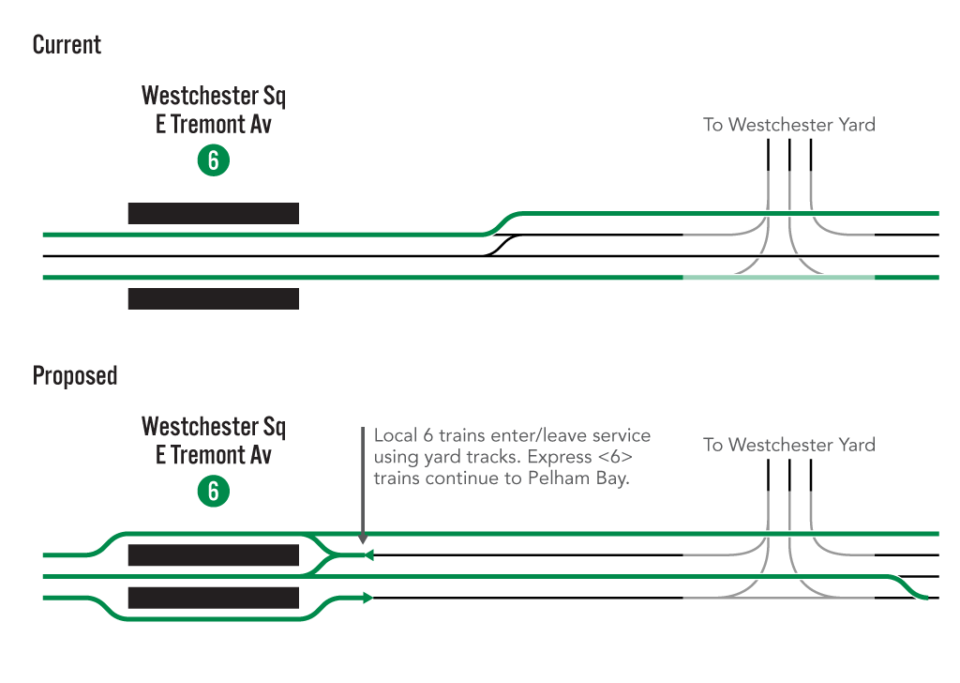
These improvements will allow the overall capacity on the IRT to be substantially increased. With fewer trains being delayed from merges and tight curves more trains can cycle through the system. More trains keep stations from being overfilled with passengers, causing trains to be delayed as they alight. The White Plains Rd Line could see an increase from 23tph to 30tph, the Jerome Ave Line could see an increase from 13tph to 30tph, and the Pelham Line could see an increase from 19tph to 30tph.
While these changes are not exactly cheap, the costs would be a fraction of what a new subway line would be. Overall, these increases equate to 35 more trains per hour or what a full 2nd Ave Subway could support. Keep in mind that this doesn’t even include expanding 1 train service and what deinterlining could mean for more IND Concourse Line service.
Fantasy Expansion Porn
I realize that so many people love my site because of the fantasy maps I’ve made. It’s far more exciting to imagine new lines than it is to come up with little fixes. I think it’s important that if we are going to expand our subway network we do so with a strong foundation. We should try to wring out the most capacity out of the existing network before we try and expand it. Otherwise, we will be forced to overbuild, a doubly terrible prospect when considering the outrageously high costs this city already has.
In the “short term” I’d like to see the 2nd Ave Subway extended west under 125th St. With limited resources it will be far more useful as a crosstown line than another radial into the Bronx. I’d also like to see the 6 extended north from Pelham Bay Park to Co-Op City.
The current subway serves the Manhattan market well and the buses pick up the crosstown market. Therefore, any new subway line should try to serve the crosstown market in some way. Looking at the map it’s clear which lines would see improvements from better crosstown connections. The White Plains Rd and Dyre Ave Lines hit 149th St but they miss Hunts Point and offer no way to get to Westchester Creek. The Pelham Line serves these two areas but misses any connection further west into the Bronx or even into midtown west.
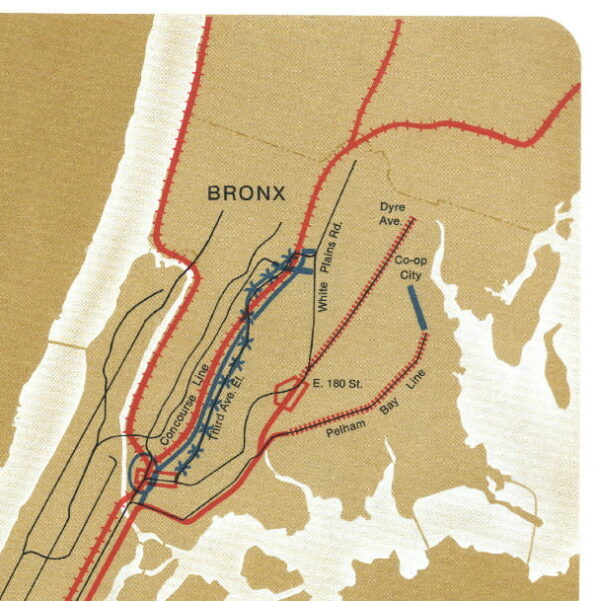
Historic plans for the 2nd Ave Subway into the Bronx centered around converting either the White Plains Rd, Dyre Ave, or Pelham Lines into the 2nd Ave Subway with service along the east side and a branch to midtown west. It’s no secret why the Q train extension to the UES has been so popular; it creates a new one-seat-ride for many on the east side, allowing riders to avoid the congested transfer at 59th St and Lexington Ave.
The current system has the capacity for growth. But one day it might make sense to swing things north. Even with a deinterlined IRT in the Bronx the Dyre Ave and White Plains Rd Lines are branched and can never see full utilization. Given the crosstown demands seen around the Bronx, it might be worth reimagining what these radial lines are capable of.
The most obvious first stop for a 2nd Ave Subway extension into the Bronx is up 3rd Ave to 149th St with an intermediate stop at 138th St. Since the 3rd Ave corridor is now served by the Harlem Line Regional Rail, we can send 2nd Ave elsewhere. In the 1970s plan the 2nd Ave Line would have taken over the Pelham Line at about Whitlock Ave station. 6 trains would have been cut back to Hunts Point Av. The beauty of this plan is that it converts the Pelham Line into a de facto express line through the South Bronx. This also eliminates the need for the peak direction express service, simplifying train moves and reducing delays.
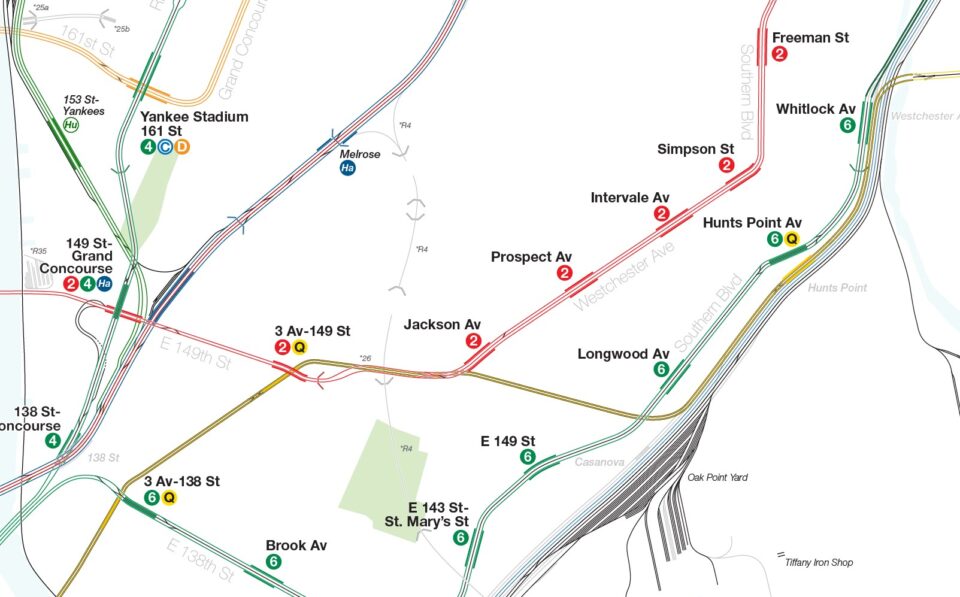
The Pelham Line sees high ridership headed towards central midtown. Therefor the Q train makes a good candidate for taking over from the 6. The fewer stations along 2nd Ave in Manhattan also speeds up travel time enough that it can reduce riders from switching to the Lexington Ave express. Under current frequencies Q trains would need to run at 16tph to make up for the loss of the 19tph that the 6 trains run. (B Division trains are wider and can hold more passengers than A Division trains of the same length.) If the Broadway Line is also deinterlined (as I’ve outlined in past posts) then the Q could run at higher frequencies, allowing for ridership growth.
The original plan called for the 6 to terminate at Hunts Point Av but still access the Westchester Yard via the middle track on the Pelham Line. As no cartographer likes a blank spot on a map, I too see that ending the 6 at Hunts Point Av seems wasteful. I propose, then, that the 6 be extended north along the NEC and connected to the 180th St station as the NY, B & W RR once did and continue on to Dyre Ave. The old ROW which connected the two lines has been myopically redeveloped so a new elevated track would need to be built along the Bronx River as it curves into the station. A new set of tracks and platforms would be built on the outside of the current station so that 2 and 6 trains can operate independently. This connection then allows 6 trains to use the Unionport Yard instead of the Westchester Yard.
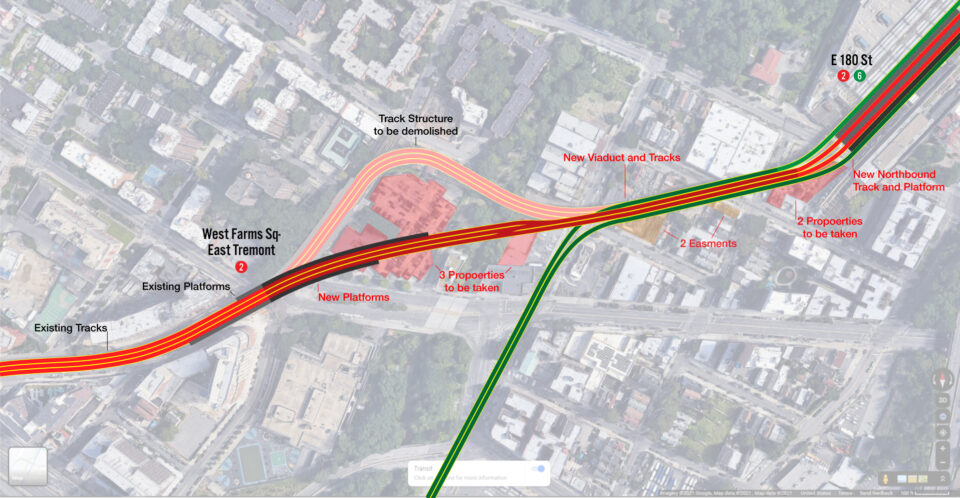
This connection may at first seem like I’m coming up with an excuse to extend the 6. After all, wouldn’t it make more sense to simply extend the Q up to Dyre Ave and leave the 6 alone? Flipping the lines would reduce travel times for all riders rather than on just one line. The flip would provide more riders with a one-seat-ride rather than forcing a larger percentage to transfer, adding time. The direct crosstown connections this flip would create would make both lines more effective.
But if the 2nd Ave Subway is extended into the Bronx what happens to the Cross-125th St Line? At first, I thought it could just be a branch, the N train at first or the T if 2nd Ave is ever extended below 63rd St. But if we are going so far as to build a new subway line then I’d like to see it used to its full potential. That means that the 125th St Line would need to be converted into a shuttle.
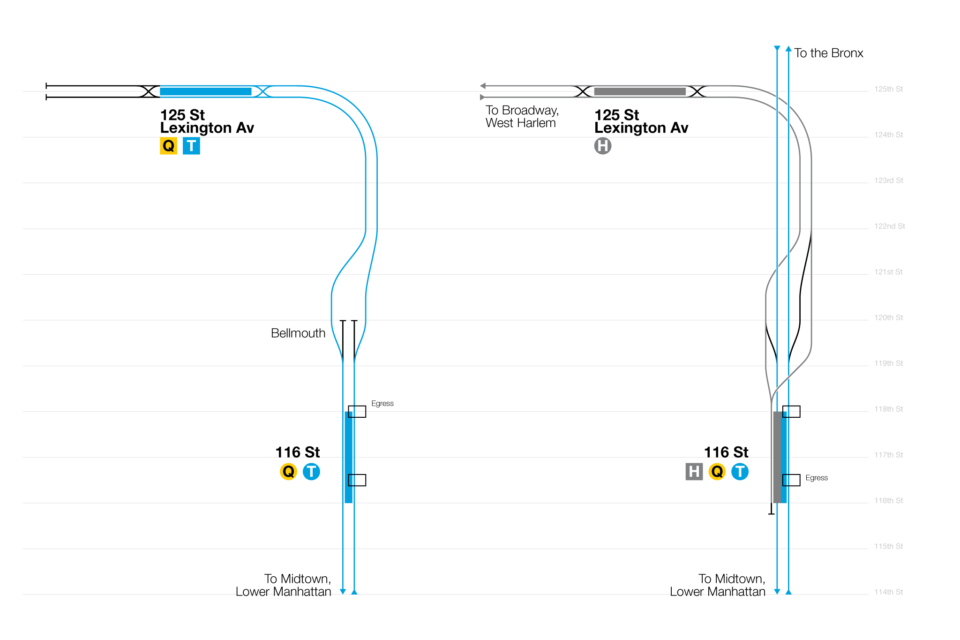
On Twitter I sarcastically suggested that the mezzanine levels of the 2nd Ave stations were so large that you could install express tracks on them. This got me thinking if this was actually possible and I think I’ve designed a somewhat elegant solution. In order to be most effective a new crosstown line would need to hit each of the north-south trunk lines in Manhattan. Simply ending at Lexington Ave isn’t an option. The 116th St station is being designed so that the two egress points are on the east side of the avenue. The mezzanine space above the southbound track could have a single track installed so that the mezzanine now becomes an island platform with access to the platform below. The egress points are not obstructed. New connecting tracks would be built between the upper level and the tracks curving over to 125th St. The track connections between the 125th St Line and the Bronx extension would remain so that trains can still be operated between the lines if necessary and for non-revenue movements. 2nd Ave can now see full service and the Harlem shuttle can see about 15tph given the single-track terminal.
What will this all cost?
The problem is that MTA costs seem to be created by throwing a dart at a board of random numbers and then adding 20%. But we can at least work out an estimate.
The projected cost of Penn Access is $88mil per station. That seems high but ill use it. Adding 4 new stops on the Harlem Line and upgrading Melrose & Tremont = $440mil (although I can see the 149 St stop being higher).
Rogers Junctions rebuild costs have ranged anywhere from $100mil to over $1bil. I’ll be conservative and go with the $300mil estimate. Layup tracks at Flatbush Ave: $600mil. Rebuilding 143rd in Harlem I’ll base off the new South Ferry station: $530mil. Expanding the Bedford Park Blvd and Westchester Sq stops for better ops: $150mil.
Grand total (completely hypothetical): $2 billion. $2b which would fix systemic problems and add into the network ~35tph. Building the 2 Av subway to 125 St is upwards of $6b. Extending it to the Bronx instead, at those costs, would push $9b. I think the choice is obvious.
Conclusion
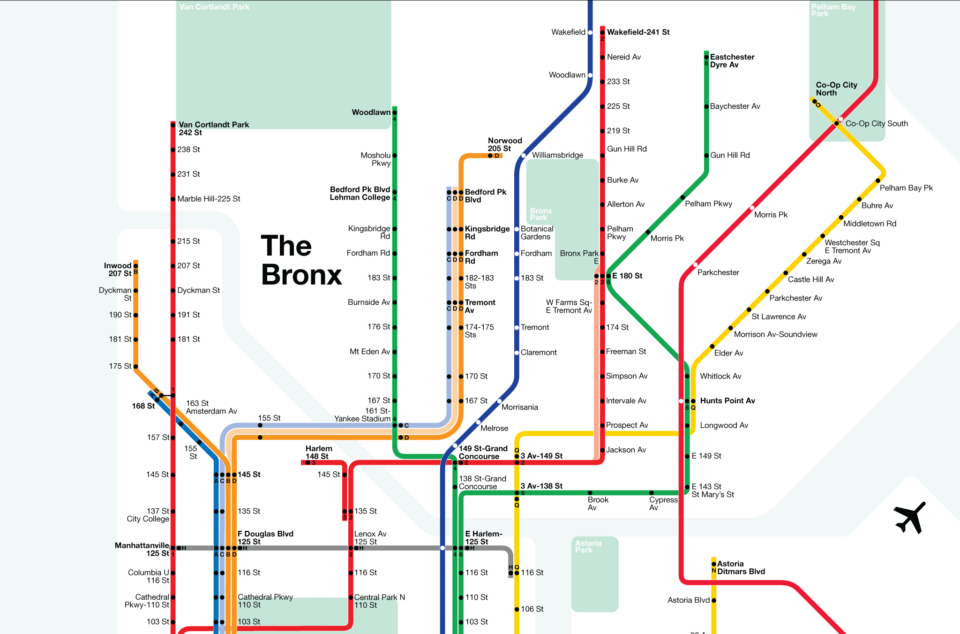
On many of my past futureNYC Subway maps I’ve left the Bronx as almost an afterthought. This wasn’t to be mean. We’ve seen that the Bronx has very good transit coverage and in places that aren’t so good we have relatively affordable options to increase service. With smart investments in the existing network we can improve service for the entire city rather than building a new line which will run well under capacity in just one place. Once we have made these easy changes we can focus on the big lifts. With better transit the Bronx will continue to grow and as that happens a clearer picture will form of where we need to spend the big bucks.
Special thanks to Uday Schultz for many of the ideas and graphics used in this post.

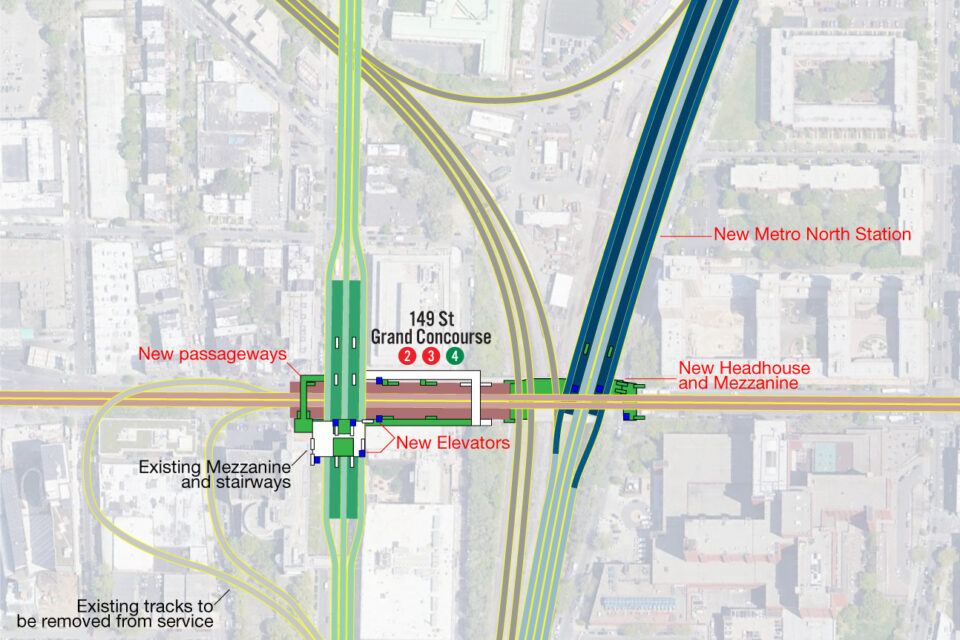

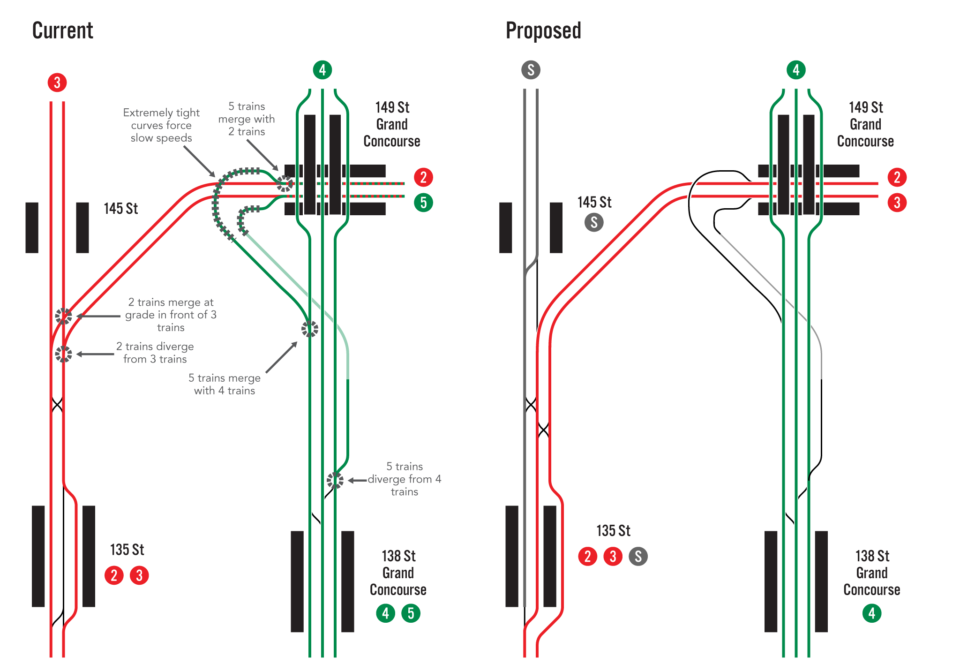
Seeing as the Bx12 is by far the most popular bus route, I’m curious as to the feasibility of a crosstown Fordham Rd/Pelham Pkwy line. This would solve the issue you point out of cross-Bronx connections, and at least the Pelham Pkwy section of the line could be constructed fairly cheaply using cut-and-cover in the extremely wide parkway median. From your track map it seems that it could branch off from the A South of Dyckman St, ideally with a stop also at 207th and 10th Ave to connect to the 1 before going to the Bronx. This “K” service would only lead to reduced A service at 207th/Broadway and Dyckman St, and then go to Lefferts Blvd while all A trains go to the Rockaways.
I’ve heard this suggested many times and it has never been a realistic idea. First the terrain of the western Bronx would make any such subway, especially one originating in Inwood, very hard to build. Second, and most importantly, the ridership going crosstown isn’t going to Inwood or the A. And if they really need to get to the A they can hop on the B/D and transfer at 145th St. The ridership is between the 4 and Co-Op City, especially where there are many jobs and no transit.
The Concourse Line, which is aimed up at the eastern Bronx, would certainly be useful but would run a bit too far north of Pelham Parkway to catch those riders. It sucks because it’s otherwise so perfect for a crosstown line.
So then could the B branch off from the Concourse Line at Fordham Rd?
Looking at job data along the Bx12 it really looks like most riders are going to Co-Op City or Yeshiva/Albert Einstein. I’m curious to see what impact on Bx12 ridership a new Metro North station there will have. I suspect that extending the 6 would have a bigger impact than extending the D.
It would indeed be very beneficial for the Bronx to have an underground subway line along Fordham Road and Pelham parkway connecting the East and the West Bronx. It would alleviate a great deal of congestion and would be a great connector between those two important cornerstones of the Bronx. The terminus point would be inwood 207th Street Broadway and then have stops at 207th Street and 10th Avenue, sedgwick Avenue, Jerome Avenue, Grand Concourse, Fordham Univ/Plaza, Bronx Zoo, White Plains Road, Williams ridge road Pelham Bay Park and terminate in Co op city.
Perhaps the teeminus at 207th Street could also provide a connection for continuation to lower Manhattan and Brooklyn perhaps.
The obvious solution would be to make it elevated, not underground, from Webster Ave eastward. Also, you wouldn’t extend the line from Inwood, but rather abandon Inwood and use the existing tracks towards the 207th St yard and a new bridge over the river. Then the only new tunneled section would be 1.7km long with 1 or 2 stations (transfers to 4 and D – possibly shared) in it.
Very good idea you had a subway line running through 3rd ave at one time it would help to extent the trains so we don’t have to take a bus to catch a train I wish you would do ut
I would be interested in knowing your positions as to whether or not a Castle Hill / Throgs Neck Line similar to the old Second System proposal would be viable given the potential ridership and demand in the area. Also, going off of the prior thread, you stated that a Concourse extension would certainly be useful, but would it be worth the investment to build the extension as opposed to improving service along the bx12 corridor with additions such as full grade separation along Pelham Parkway?
The whole Soundview area doesn’t see enough potential ridership to justify any heavy rail. Bus lanes will serve the area well and get riders to the subway quicker.
Would it be worth the investment to extend the D rather than improve the Bx12? We are talking about a few billion vs a few million. I won’t say it will never be worth it but I don’t see it happening anytime soon.
As someone who lived and grew up In Soundview, yes, there’s ridership. We all board buses to the 2,5 and 6 trains. Trust me, there’s a demand.
You also made a mistake with the 6. Express trains do not terminate at Parkchester. The travel all the way to Pelham Bay. Ita the local trains that terminate at Parkchester. There is no bottle neck there. Express and local trains arrive at different times at parkchester. Local trains relay on the middle track. Express trains in the peak direction switch between local and express north of parkchester.
Rogers jct needs to be rebuilt, but service patterns need to stay as it is. Current patterns gives both New Lots and Flatbush one local and one express and one west side and one east side line each.
Same thing with the 2 and 5 in the Bronx. One east, one west.
Now for the Dyer and White Plains lines. The main reason the 5 trains serves Neired isn’t taking away Dyer Ave service. Those 5 trains are “put-ins/lay-ups” from the yard there. They are supplement trains for rush hour service on the 5 that adds trains to the line without congesting up terminal space at Dyer.
All the data which I have presented here shows that there are indeed problems with how we run our trains. Changing them will make things better for most, although I agree that isn’t for all. Change is scary to people who can’t see the better way and yet we change our habits all the time. Loss of a direct express is made up for with a transfer at half the time, a transfer many already make.
How do you propose creating sufficient Metro North local frequency in the 3rd Avenue area? Currently Metro North runs upwards of 40 trains per hour during rush hour on its four-track line through the Bronx. With the additional stations, non-stopping trains can’t really use the local tracks without prohibitively low levels of service at them (like today). Would many more local New Haven and Harlem Line trains spend 5-10 minutes making the Bronx stops, or is there another way you would propose changing their schedules?
The Harlem Line runs 15tph going into GCT in the AM. New Haven Line runs 21tph going in. Hudson comes in with I think 14tph. But reverse peak is paultry. So you can sacrifice the two express tracks for longer distance service, both going in peak direction, while having all the local Harlem trains (which would only go to/from North White Plains) make those stops. 15tph is enough for the corridor.
Seeing that the Bx12 covers the most essential crosstown service in the Bronx (and is the second most heavily used route in the entire system, deserving SBS distinction), would it be a reasonable investment to build fully lane-separated BRT infrastructure all the way from Pelham Bay Park or Co-Op City to Fordham and Concourse/Jerome, with provisions for an upgrade to LRT?
Yeah I’d say so. Given how wig Pelham Parkway it’s kind of surprising they haven’t already.
Pelham Pkwy is definitely a corridor suitable for transit lanes. You mentioned in a previous comment that the Soundview/Clason Point/Castle Hill area doesn’t have the population density to support anything more than a bus, despite most of the area being cut off from good transit access by the Bruckner Expressway. What are your thoughts on a conversion of the Bruckner Expwy to an at-grade boulevard (something akin to Eastern Pkwy or Ocean Pkwy), building a separated busway in the middle of the new Bruckner Blvd? Upgrades to the Sheridan Pkwy Highway and a modification of the Bronx River Pkwy connection to Bruckner would be necessary for this.
I’m for it. But it being a major truck route it probably can’t be as nice as Eastern Pkwy.
It is a shame that the N line terminus in Astoria can not be connected to 125th St (or can it?) That way, you could have your H and the N as ONE LINE (no shuttle needed). The tracks would have to go underground once you get to (let’s say) Ward’s island (similar to the way the R does now after Queensborough Plaza heading towards Manhattan). Such a line could be built from 125 St East to 125th St -2nd Avenue (a stop curiously missing in your proposal– WHY?) . It would continue underground (paralleling the Triboro Bridge nearby until it has to go above ground to link to the present elevated N train). Costs: plenty. Benefits– probably many. Feasibility: unknown. Comments, please….
Extending the Q train into the Bronx is intriguing but the flaw in your proposal is that the Q trains have a wider track and can’t run on the IRT tracks which are narrower
The tracks are the same distance apart. It is the platforms on the IRT which are wider. However the IRT stations on the Pelham Line were designed so that they could be easily shaved back.
They were built to Triborough specifications, which is basically BMT Eastern Division size. I don’t know if you could run 75 foot cars there.
They probably won’t ever have to. The MTA only wants to order 60-foot cars for the B-Division lines. A hypothetical extension of the Q into The Bronx would almost certainly happen after the R68s and R68As are retired. So if the Pelham Line ever crosses over to the B-Division side, it will be with R160s, R211s or the R68/R68As’ replacements.
This is just my idea. I have no idea for the upcoming plans of the route of choice. I don’t know if anyone would agree on maybe having that extension of the 2nd Ave Line cross from one side of the Bronx, to the other side. Saving people some time from transfering more than 2 trains to reach the (1-6) Lines and (A,B,C,D,E,F,G,J,L,M,N,Q,R,S,W) Trains. Might’ve forgotten some, but what I’m trying to suggest is maybe having a line that cuts from the West Bronx to the East side. It may help commuters, and be more convenient.
With the possible exception of a Lafayette Avenue branch (which would only give you some transfers), I don’t think SAS is the best way to realize rapid cross-Bronx transit service.
The “easiest” one that accomplishes these goals is the D extension to Co-op City, but not exactly cheap (though one could mitigate costs by building some or most of it as an el).
Even easier – build the full Fordham Road/Pelham busway for the 12 Select, fully separated from traffic. I once favored something like a Fordham Road subway, but the grades are prohibitive between Webster Avenue and University Heights. Might be able to upgrade to LRT later.
For many reasons, I’d love to see the Cross Bronx Asthmaway demolished and replaced with a subway. ROW isn’t exactly ideal, but with some mods, could connect all subways.
Well that’s one good way to look at the Bronx changing needs.
I gotta admit that 3rd Avenue subway probably won’t be necessary. And this is a great alternative. Both the 3 and 5 would be eliminated since they probably won’t even need to exist since the Harlem shuttle 2 4 and 6 train would replace them
I would recommend keep the 3 train pattern as a shuttle and maybe if they is enough demand maybe the 5 train can be the peak way express or maybe skip stop on Jerome ave
And building infill stations on metro north is a good idea too
I not really a fan of the Triboro rx rail proposal either so I too believe that a metro north penn station access with stations in queens is much more worth the cost.
Nice job. I wonder what a 2nd ave extension to queens or Brooklyn would look like. Look forward to seeing it.
Good proposals……
The change of the 3 train…. From 148 St…. They currently can get a seat going downtown…. In the proposed they have to get off the shuttle, wait for the 2 or 3 and may not get a seat… Not a big thing. Would your proposal keep the Lenox Yard?
Any thought of using the N and/or W trains to Bronx? It’s already close to the Hells Gate line.
Working for the system has it’s advantages.
But overall good proposals.
Nobody is suggesting light rail. They are studying it in Brooklyn to Queens. Why not lay a light rail line that follows the 3rd Ave line that was torn down in the 70s ending at Gun Hll & White Plains Rd have a spur that turns at Fordham down Pelham to Coop City with a stop at Westchester Creek then connect via one of the existing bridges or a tunnel to the proposed queens/Brooklyn light rail. Having to go to Manhattan from the Bronx adds travel time and this would take riders of of the existing trains who are traveling to Manhattan because they’re going to queens or Brooklyn. The same gauge track and trams would connect 3 boroughs without the need to go into Manhattan.
Interesting article! I agree with most of what you said, just wanted to offer my own alternate IRT deinterlining proposal that would create a second transfer station near Hunts Point to relieve transferring loads at Grand Concourse.
https://www.google.com/maps/d/u/0/edit?mid=1xRFD69lyiSkhCVO2N-99xyyaTXQ-VhS4&usp=sharing
I’m looking for feedback on it so any comments would be appreciated. Thanks
I like it but adding reverse branching with the Lex exp and lcl is a bad idea. Unless I’m misreading that part.
No, there are existing switches at 125th/Lex that would allow all locals to go to Jerome and all expresses to go to Southern Blvd without interfering with one another.
But now you are making Jerome rides longer. That’s a non starter.
But the advantages are pretty clear too:
– White Plains Road riders keep the popular Lex express service, single-transfer for 7 Av
– Pelham riders maintain single-transfer ride for the Lex express, and the 7 Av Express is a slightly quicker way to get to Midtown than the Lex Local
– Harlem maintains one-seat ride (though it could still theoretically be converted to a shuttle)
– Crucially, two transfer points between Lex and 7 Av in the Bronx will help to relieve the loads of passengers transferring between the two lines.
Without speaking from experience (I haven’t lived on the Jerome line), Jerome riders do get the shaft. They would have to do a cross-platform transfer at 125th, just like (6) riders do today. But in return for being the sole local, Jerome riders would see a much more frequent and reliable service. It could be possible to run trains, though I don’t know how well that would work out. If people really wanted a one-seat express ride to Midtown, they could also catch a train from Grand Concourse.
Sorry, when I said “It could be possible to run trains” I meant “It could be possible to run express (4) trains,” sorry for the formatting issues
So you are reverse branching locals and express trains. Bad idea.
So then would all locals on Jerome, all expresses on Southern, with peak directional expresses along Jerome work? Maybe this is an unworkable idea, just wanted to try something different.
It sounds like you are just swapping the existing 6 services on Pelham over to Jerome. Then it sounds like you are swapping the 2 and 4 on White Plains Rd (5 stays the same). The new crosstown 2-Pelham Line is the best part.
To simplify things why not send the 6 up to White Plains Rd and make the 5 now Lex local too (do the peak express on the 5 from 180 to 138). As long as there is a transfer between these and the 2, as you have on your map, it could all work. From a construction standpoint it is more complicated than my alignment: you need the new subway tunnel, two stations, and portal on Southern Blvd as well as a new elevated station and track to connect the 2 to the Pelham Line. Nothing outrageous but certainly more costly.
This is not a bad idea at all. I just don’t know if it’s worth the extra cost. Remember anything I’m doing up that way is AFTER all the deinterlining and regional rail integration. But it’s certainly an alternative to consider.
Great plan. Personally I would leave the Bronx IRT unchanged. But I would switch the northern terminals of the 2 and 5 lines north of East 180th Street. The 5 train would take over the north white plains rd line and the 2 train would take over the dyre ave line. The White Plains Road branch is about 4.5 miles long with 10 stations, while the Dyre Avenue branch is about 4 miles long with 5 stations.The peak way express service should serve the longer, higher-ridership branches; under this reroute the 5 runs express south of East 180th Street, it no longer has to cross over the local tracks to reach the center track. Or just have the 2 train Run peak way express and 5 train fully local
As someone who once lived near the 4 for most of my life, let me put it to you like this:
At least before the Rona, if you got a seat at Fordham Road around 5 AM heading south (to say nothing of the actual rush hour), you were lucky. Put another way, the Jerome is capital-B Busy. They should keep the express. Heck, the 4 alone is likely insufficient. ‘Tis why I favor sending the 5 up Jerome in a hypothetical Bronx IRT de-interlining, but only after major improvements at 149/GC and with SAS picking up some slack. (I am coming around to regional rail as a “replacement” for the 3rd Avenue-SAS branch, but I don’t think this obviates an SAS-Bronx link entirely.)
That said, this is certainly an interesting de-interlining idea – one not without its merits.
I agree with your opinion on a SAS Bronx line. I personally believe that maybe a 4 track line might be needed for 3rd ave line since it has a high population but that might be a bit overkill. Ideal they should be a new train yard. But where. Should it be elevated or underground. But that’s a proposal for a another time
I like it, if you run the 4 express and the 5 and 6 local. It creates a nice X-Y axis for the eastern Bronx (the 2 as the X-axis and the 5/6 as the Y-axis) and would make intra-borough subway trips a hell of a lot easier with Hunts Point Ave serving as the transfer hub. And you can still have the 5 run peak express between East 180th and 138th St-3rd Ave.
If I’m honest, I don’t understand how you’re going to get another 15 tph down the Metro-North line into GCT. Firstly, there’s the line itself. The frequency is so low because (a) they use the local tracks for express trains; they’re out of space on the express tracks, and (b) New Haven line locals (and not-so-locals) stop in Fordham, but skip all other stations, clearing several potential train slots. The obvious fix is to either make those trains stop at Bronx stations (very unpopular) or just cancel the Fordham stops altogether (also not good; lots of NH line passengers use it and the connection from Fordham to the NH line region is somewhat important). Then there’s the problem of GCT capacity: If they had any more, they’d be using it; plenty of trains are standing-room only. Currently (including reverse-peak, pre-covid) 50tph run to GCT, plus your 15 makes 65tph. The problem here isn’t necessarily the sheer number of trains, because the 3 peak-direction tracks can carry up to 24tph each (given the signal capabilities, I think this is fair) for a total of 72tph. The problem is instead more complex.
Firstly, there’s travel variability. On the metro-north, the service patterns are arranged in a way that trains from further away merge with trains closer in. For example, in the mornings, the express track is comprised of trains from: New Haven-Norwalk, Norwalk-Stamford, Stamford-Rye, Rye-New Rochelle, and New Rochelle-Mt Vernon E. This variety of service patterns is equivalent to interlining: it’s very unreliable, and long travel times make this worse. Not to mention, the many speed changes and long distance make this variety worse (source: used to ride this every day) Cutting service patterns isn’t doable: it makes already-long commutes longer and is very unpopular. In essence: precision running is almost impossible, leaving tight frequencies per express track a total fantasy. They manage to (sort of) south of 149th because trains literally just pile up at the moment, and then get cleared to fill capacity.
Speaking of 149th st, that is a reason in and of itself. The interchange between Harlem/NH and Hudson is terrible. A totally at-grade intersection with at least 5 direct train clashes that makes sure that capacity into and out of Grand Central is kneecapped. Dispatch has decided that it would be easier to just run reverse-peak morning Hudson line trains up track 3 to minimize conflicts, deeming it worth the costs of a bidirecitonal track in the middle of rush hour.
Thirdly, and possibly most obstructively, is politics. You said in the article that the reverse-peak service is weak and can be cut. Maybe – but MNR has identified this as a strong growth area (was driving all ridership growth pre-covid), and that was the most obvious way to grow ridership and transition to regional rail, as you mentioned. The regional rail would just be for regions further out, and actually don’t hav other transit service. Cutting those trains for bronx service is contentious, and probably a terrible idea. It is worth noting that CT wants to use the NH line reverse service to try and ease i95 congestion, which requires… more reverse peak service. MNR has been making similar motions with express, reverse-peak trains to White Plains. It seems that the cost-benefit is really out of alignment here.
I think you are totally misunderstanding what I’m saying. I’m not ADDING 15tph to the peak direction but rather having them stop at the new local stations as a local subway line would. New Haven trains would then use the express tracks. This would require a new “express” station in the north Bronx; I’d love it to be Fordham but I don’t think there is room, so maybe Williams Bridge. Then riders can transfer. Penn Station Access will see some NH trains rerouted to Penn Station so we can use that extra space on the Harlem Line for Southeast express trains.
Also I didn’t say reverse peak would be cut but INCREASED to support more reverse peak ridership.
As you state the convoluted way we run our trains causes a lot of problems. The point of Regional Rail is to simplify and streamline operations to eliminate these problems.
In fairness, even the MTA aren’t proposing the line continuing west on 125th (yet!). Though they are designing the 125th St station to do just that. Personally, I do like extending the SAS to The Bronx, because as a native Bronxite, I do think the MTA did my borough wrong when they tore down the Third Ave El in 1973 and the replacement Bx55 Limited bus was a poor substitute. That said, I do think a “Bronx Local” on Metro-North with the same fare and transfer privileges as Transit buses and subways together with a infill stations would be a big improvement for a fraction of a Third Ave Subway.
It also sounds like Waters Place/Westchester Creek is a much bigger jobs hub than I thought. It’s unfortunate that the 6 only skirts it. A line along Amtrak’s Northeast Corridor (once proposed as a Bronx extension to Co-Op City) would hit it. I thought about the possibility of the B (or C with a de-interlined CPW/8th Ave Line) branching off Concourse running via Fordham Rd/Pelham Pkwy to Co-Op City. It would relieve the Bx12 for sure. But like the 6, it wouldn’t directly serve Waters Place, though it would serve Jacobi Hospital. And it would have to tunnel somewhere between Stillwell Ave and the Hutch to get to Co-Op City.
But I wonder if branching off the 6 might be a better alternative for hitting Waters Place, the hospitals and Co-Op City. The branch would start at the Westchester Yard leads, go through the yard, and join the NE Corridor from Waters Pl to just past the Hutch/95 interchange, then turn north to serve the center of Co-Op City. It can’t be tunneled due to the marshland Co-Op City sits on top of, so I’m not 100% sure of where to turn north.
Well I will say this in my honest opinion in the current 2nd ave plan phase 2 is ok. Phase 3 is poorly designed and phase 4 is just downright unnecessary. So a lot of work still needs to be done for the 2nd Avenue line but this is a good place to start.
I also like the idea of having the Q take over the Pelham Line past Hunts Point Ave, though I imagine it would be one hell of a climb from from the Northeast Corridor in an open cut to the elevated 6 line over Westchester Avenue. At least the 6 can possibly remain elevated alongside Amtrak before peeling off for the approach to East 180th Street via Devoe Avenue. Even with the removal of the Sheridan Expressway (yes, please!), it’ll still probably require some taking of property. But it does look doable. Though what route do you have the Q taking between 149th St/Third Avenue and Longwood? It looks like it’s somewhere north of the 2 line on Westchester Avenue.
It would be the exact same climb the 6 makes from underground to elevated so I don’t see a problem.
The only property taking, or property affected, would be up at 180 St since the original ROW has been developed. Luckily, for now, any property affected is like a 1 story garage. Not a big loss. But this is being proposed as being a long ways off and these could be redeveloped.
The Q would run north from the Harlem River under Lincoln Ave to 3rd Ave, up 3rd Ave to Westchester Ave, east down Westchester Ave to 152nd St and then basically run under all the private property from Prospect Ave to the NEC (deep bore to avoid surface disruption).
Ah, ok. I wasn’t sure if the Northeast Corridor was at lower elevation than existing 6 subway at Hunts Point Avenue/Southern Blvd. Even then, the 6 might still need the part of the existing el structure that spans the Sheridan and the Corridor, so that it can eventually transition down to the railroad’s level and cross the Bronx River. Then the Q can cross over the river on a new span and intersect the existing el on the east river bank.
I’ve been following the debates on a 125th Street extension versus an expansion into The Bronx for a long time and I believe the former option of extending the SAS west along 125th Street would be the most realistic.
If I write my own essay explaining why I believe this is the case in more detail, would you be interested in reading it?
Sure!
Thank You. The reason I want to submit my case for a 125th Street extension in essay form is because I cover a lot of ideas that are to intricate to distill to a single comment. I will email it to you once it is finished.
Great assessment of the SAS and the Bronx. As a native Bronx resident I like that you emphasize cross-Bronx travel and the benefits of more frequent MetroNorth service lieu of expanded subway service.
CROSS-BRONX TRAVEL
I grew up in Riverdale/Spuyten Duyvil and so I depended on the 1 train from 231 St-Kingsbridge to get to Manhattan but to get the rest of the Bronx I relied on the Bx1 and Bx9. A train solution to this like having the 1 and 4 trains meet in Van Cortland Park or a new service using the freight line from 231 St-Kingsbridge, alongside the MetroNorth Hudson line as far as 149 St-Grand Concourse.
1 TRAIN SERVICE EXPANSION
You mention briefly in your article a 1 train service expansion, I assume this means reinstating the 9 train as a third track peak express?
BROADWAY ELEVATED EXTENSION
I currently live in North Riverdale and most often take the BxM1 express bus service as it’s the most direct route to Manhattan. If I want to take the subway then I depend on the Bx7 or Bx9 to get to the 1 train increasing my travel time by up to a half hour depending on how long I have to wait for a bus. Also I sometimes take MetroNorth to Riverdale but from there I depend on the Hudson Rail Link buses as the station is in a very inconvenient location. I’ve also in the past commuted north to Yonkers taking the Bee-Line bus system from Broadway.
All of that is to say I often wish the Broadway elevated was extended north to the border with Yonkers which would mean I wouldn’t have to use any of the premium services (MetroNorth, express bus) or extraneous transfers (city bus, Hudson Rail Link, Bee-Line). I assume there’d be 2 main obstacles—a very poor business case and a bitter political fight with residents on Broadway. An extension of the elevated definitely goes into the realm of “Fantasy Expansion Porn.”
The best solution in my opinion would of course be the most expensive—bury the 1 train using cut and cover under Broadway entirely or at least from Marble Hill and extend it as far north as 262 St-Caryl—and maybe create a bus depot there for the Bee-Line. Arguably development along Broadway could justify this but still, what a fantasy that would be.